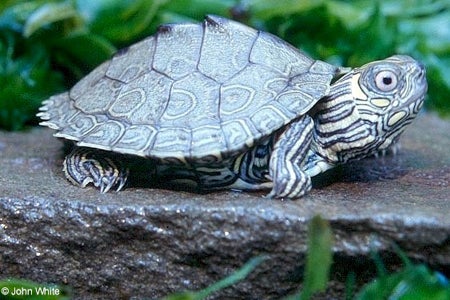SCIENTIFIC NAME:
Graptemys geographica
STATUS:
Uncommon to locally common in Interior Plateau, Appalachian Plateau, and Ridge and Valley. Absent from Coastal Plain, but occurs in Tennessee River system as well as upper Mobile Bay drainage (Black Warrior, Cahaba, and Coosa river systems). Low Conservation Concern.
DESCRIPTION:
Northern map turtles, also known as common map turtles, receive their name from light markings/lines on their skin and carapace (back of shell) that resemble waterways on charts or maps or contour lines on topographic maps. These lines are thin yellow to orange stripes running somewhat parallel on the skin with an oval shaped yellowish spot on the side of the head behind the eyes. The skin is brown to black. The carapace is olive-green to grayish brown with yellowish markings/lines in a reticular pattern. These lines are more pronounced on younger turtles especially on the carapace. As the turtle becomes older their pigmentations on the carapace become darker and tend to blend together. The plastron (bottom of shell) is cream colored and has no markings. Adult females are much larger than males, sometimes weighing five times as much. On average the female’s carapace will be 7 to 10¾ inches long while males average 3½ to 6½ inches long. Males have longer thicker tails, longer claws and a more oval shaped carapace than females. They also have a more distinct dorsal keel. Hatchlings are about 1 inch in length and look much like the adults. However, they display brighter colored pigmentations and have a rounder shell with a more pronounced dorsal keel than adults. There are a total of ten different species of map turtles found in the eastern United States.
DISTRIBUTION:
The Northern map turtle’s range extends as far north as southern Ontario and Quebec in Canada, south to northwestern Georgia, and west to Oklahoma and Kansas.
HABITAT:
Northern map turtles inhabit slow moving lakes, rivers, streams and ponds with abundant aquatic vegetation. They prefer large bodies of water with muddy bottoms. Map turtles require ample areas for basking such as exposed rocks, stumps, fallen trees or other floating debris.
FEEDING HABITS:
Northern map turtles always eat while in the water. Due to their larger size, females tend to eat larger prey than males. Females consume mussels, snails, clams, and crawfish. Males eat smaller crustaceans, snails, aquatic insects and larvae. Both sexes are also known to eat carrion and aquatic vegetation.
LIFE HISTORY AND ECOLOGY:
Northern map turtlesare gregarious, often found basking in groups on floating logs and other debris and along steep banks. They are very wary and retreat to the water for safety at the slightest disturbance. They rarely leave the safety of the water and come out on dry land only during nesting. They are active during warmer months during daylight hours and after dark. They are dormant during the winter months spending much of the time hibernating in groups beneath submerged logs, stumps, or roots, or buried in the mud or in burrows. Breeding takes place in these deeper waters during the winter months at the hibernation sites. Males initiate courtship by tapping the females on the front with their long claws. Nesting normally occurs from May to July. The female will dig a cavity with her hind legs preferably in a well-drained sandy soil exposed to sunlight for warmth. She will lay between 8 to 20 eggs. Like most egg laying reptiles the female will then cover the nest with soil and/or vegetative debris. The warmth of the sun and heat from the decaying vegetation determines the sex of the hatchlings. Eggs will incubate 50 to 70 days before hatching. Females will commonly lay two or more clutches during each breeding period. Late hatches have been known to over winter in the nest before digging out as temperatures warm up in the spring.
REFERENCES:
Conant, Roger and Collins, Joseph T. 1998. Peterson Field Guides, Reptiles and Amphibians. Houghton Mifflin Company, NY., NY. 616 pp.
National Audubon Society. 1979. Field Guide to Reptiles and Amphibians, North America. Chanticleer Press, Inc. 743 pp.
AUTHOR:
Daniel Toole, Wildlife Biologist, Alabama Division of Wildlife & Freshwater Fisheries






